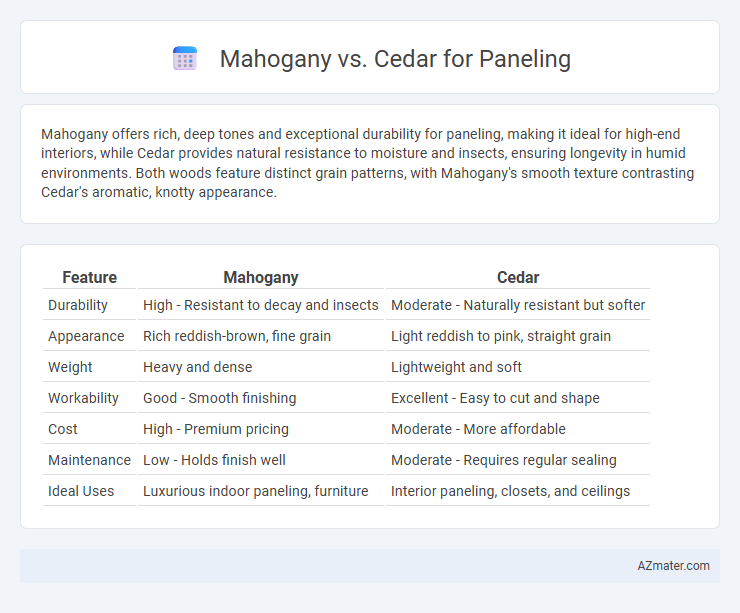Mahogany offers rich, deep tones and exceptional durability for paneling, making it ideal for high-end interiors, while Cedar provides natural resistance to moisture and insects, ensuring longevity in humid environments. Both woods feature distinct grain patterns, with Mahogany's smooth texture contrasting Cedar's aromatic, knotty appearance.
Table of Comparison
| Feature | Mahogany | Cedar |
|---|---|---|
| Durability | High - Resistant to decay and insects | Moderate - Naturally resistant but softer |
| Appearance | Rich reddish-brown, fine grain | Light reddish to pink, straight grain |
| Weight | Heavy and dense | Lightweight and soft |
| Workability | Good - Smooth finishing | Excellent - Easy to cut and shape |
| Cost | High - Premium pricing | Moderate - More affordable |
| Maintenance | Low - Holds finish well | Moderate - Requires regular sealing |
| Ideal Uses | Luxurious indoor paneling, furniture | Interior paneling, closets, and ceilings |
Introduction to Mahogany and Cedar Paneling
Mahogany paneling is prized for its rich reddish-brown color, fine grain, and durability, making it a popular choice for high-end interiors and furniture. Cedar paneling offers natural resistance to moisture, insects, and decay, with a warm, aromatic scent and a distinctive reddish hue that darkens over time. Both woods provide excellent structural integrity, but Mahogany is often favored for its elegant appearance, while Cedar is valued for its protective qualities and rustic charm.
Wood Appearance: Mahogany vs Cedar
Mahogany paneling boasts a rich, deep reddish-brown color with a smooth, fine grain that enhances warmth and elegance in interiors. Cedar displays a lighter, reddish to amber tone with distinctive knots and a more pronounced grain pattern, offering a rustic and natural aesthetic. Both woods age beautifully but mahogany maintains a more consistent coloration, while cedar can develop a silvery patina over time.
Durability and Longevity Comparison
Mahogany offers exceptional durability with a dense, hard grain that resists dents, scratches, and rot, ensuring longevity in high-traffic or moisture-prone areas. Cedar's natural oils provide resistance to decay and insect damage, but its softer texture makes it more susceptible to dents and surface wear over time. While both woods are suitable for paneling, mahogany generally outperforms cedar in terms of long-term structural integrity and resistance to physical damage.
Resistance to Moisture and Decay
Mahogany offers superior resistance to moisture and decay due to its dense, oily grain structure, making it ideal for paneling in humid environments. Cedar naturally contains preservatives like thujaplicins, which provide excellent decay resistance and repel insects, yet it is less dense than mahogany. Choosing between mahogany and cedar for paneling depends on balancing moisture exposure with desired durability and maintenance needs.
Acoustic and Insulation Properties
Mahogany offers superior acoustic qualities due to its dense grain structure, providing excellent sound absorption and minimizing noise transmission in paneling applications. Cedar, while lighter and less dense than mahogany, delivers good thermal insulation properties, making it effective for maintaining temperature regulation. Both woods enhance acoustic comfort, but mahogany excels in soundproofing whereas cedar is favored for its natural insulating capabilities.
Maintenance Requirements for Each Wood
Mahogany paneling demands regular cleaning and occasional refinishing to maintain its deep, rich color and resist surface wear. Cedar requires less frequent maintenance but benefits from periodic sealing to prevent its natural oils from fading and to protect against moisture and insect damage. Both woods respond well to gentle cleaning methods and careful moisture control to preserve their longevity and aesthetic appeal.
Environmental Impact and Sustainability
Mahogany paneling, harvested primarily from tropical hardwood forests, often raises sustainability concerns due to slower growth rates and deforestation risks, though certified sources like FSC help mitigate these issues. Cedar, especially Western Red Cedar, is considered more eco-friendly because it grows relatively fast, is often sustainably harvested, and requires less chemical treatment due to its natural resistance to decay. Choosing responsibly sourced cedar can significantly reduce environmental impact compared to mahogany, making it a preferable option for sustainable paneling projects.
Installation Considerations and Cost
Mahogany paneling requires precise installation techniques due to its dense grain and hardness, often necessitating pre-drilling to avoid splitting, which can increase labor time and cost. Cedar, being lighter and softer, allows for easier handling and quicker installation, reducing overall labor expenses. While mahogany typically commands a higher material cost due to its durability and rich appearance, cedar offers a more budget-friendly option with natural resistance to decay and insects, making it cost-effective over the long term.
Popular Uses and Design Styles
Mahogany is renowned for its deep reddish-brown hue and fine grain, making it a popular choice for luxurious, classic paneling in formal interior designs such as traditional libraries and upscale offices. Cedar, with its natural aromatic properties and rustic appearance, is often used in cabins, saunas, and outdoor spaces, lending a warm, textured aesthetic ideal for casual, country, or coastal design styles. Both woods offer durability, but mahogany's rich color complements sophisticated, elegant settings while cedar's natural knots and color variations enhance relaxed, nature-inspired interiors.
Choosing the Right Wood for Your Paneling Project
Mahogany and cedar both offer unique benefits for paneling projects, with mahogany prized for its rich, reddish-brown color and exceptional durability, making it ideal for elegant, long-lasting interior finishes. Cedar is valued for its natural resistance to moisture, decay, and insects, as well as its warm hues and aromatic qualities, which make it a great choice for environments prone to humidity. Selecting the right wood depends on your priorities for aesthetics, maintenance, and environmental conditions where the paneling will be installed.

Infographic: Mahogany vs Cedar for Paneling
 azmater.com
azmater.com